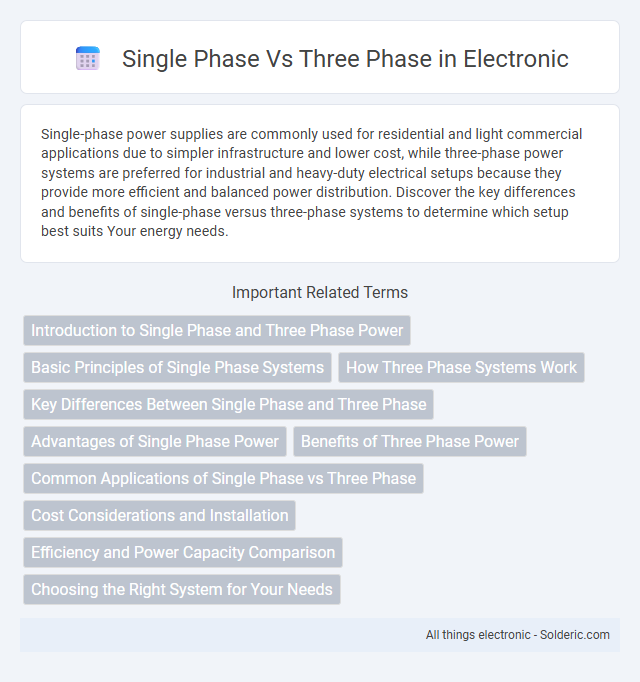Single-phase power supplies are commonly used for residential and light commercial applications due to simpler infrastructure and lower cost, while three-phase power systems are preferred for industrial and heavy-duty electrical setups because they provide more efficient and balanced power distribution. Discover the key differences and benefits of single-phase versus three-phase systems to determine which setup best suits Your energy needs.
Comparison Table
| Feature | Single Phase | Three Phase |
|---|---|---|
| Power Supply | One AC waveform | Three AC waveforms, 120deg out of phase |
| Voltage | Typically 120V or 240V | Typically 208V, 380V, 400V, or 480V |
| Power Capacity | Lower power, suitable for residential | Higher power, ideal for industrial/commercial |
| Efficiency | Less efficient for large loads | More efficient for heavy loads |
| Motor Operation | Single phase motors with starting capacitor | Three phase motors with smoother operation |
| Cost | Lower installation cost | Higher installation and equipment cost |
| Applications | Residential lighting, small appliances | Industrial machinery, large motors, HVAC |
Introduction to Single Phase and Three Phase Power
Single phase power uses a single alternating voltage waveform, typically supplying residential homes and small businesses with reliable energy for everyday appliances. Three phase power consists of three voltage waveforms offset by 120 degrees, delivering more consistent and efficient electricity ideal for industrial and large commercial applications. Your choice between single phase and three phase systems directly impacts energy efficiency, equipment performance, and overall power capacity.
Basic Principles of Single Phase Systems
Single phase systems operate with a single alternating voltage source delivering power through one live conductor and a neutral conductor, commonly used in residential and light commercial applications. The voltage in single phase systems fluctuates sinusoidally, providing a steady energy flow sufficient for most household appliances and small motors. Understanding these basic principles helps you determine whether single phase power meets your energy needs efficiently.
How Three Phase Systems Work
Three phase systems generate power through three alternating currents, each phase offset by 120 degrees, creating a continuous and balanced flow of electricity. This design allows for more efficient and stable power distribution, especially in industrial and commercial applications. Compared to single phase systems, three phase systems deliver higher power with reduced conductor material and lower electrical losses.
Key Differences Between Single Phase and Three Phase
Single phase power uses one alternating current (AC) waveform, making it ideal for homes and light loads, while three phase power delivers three AC waveforms, providing consistent and efficient energy for industrial and heavy machinery. The voltage in single phase systems typically ranges from 110V to 240V, whereas three phase systems operate at higher voltages such as 380V or 415V, enabling better power transmission and reduced losses. Your choice between single phase and three phase impacts equipment performance, energy efficiency, and installation costs based on power demands.
Advantages of Single Phase Power
Single-phase power offers simplicity and cost-effectiveness, making it ideal for residential and small business applications where energy demands are moderate. It requires less complex wiring and equipment, which reduces installation and maintenance expenses. Your home or small facility benefits from reliable power suitable for everyday appliances without the need for high power loads associated with three-phase systems.
Benefits of Three Phase Power
Three-phase power delivers higher efficiency and more consistent power delivery compared to single-phase power, making it ideal for industrial and commercial applications. It enables smaller, lighter electrical equipment and motors to produce the same output power, reducing installation and maintenance costs. Additionally, three-phase systems provide better voltage regulation and increased reliability, minimizing power interruptions and improving overall system performance.
Common Applications of Single Phase vs Three Phase
Single phase power is commonly used in residential settings and small businesses, powering appliances, lighting, and small machinery. Three phase power is prevalent in industrial and commercial environments where heavy machinery, large motors, and HVAC systems require higher efficiency and more consistent power delivery. The three phase system supports larger loads with better voltage stability and reduced conductor material compared to single phase systems.
Cost Considerations and Installation
Single-phase systems generally have lower initial installation costs due to simpler wiring and fewer components, making them suitable for residential applications and light commercial use. Three-phase systems require more complex infrastructure, increasing installation expenses, but offer greater efficiency and capacity, ideal for industrial and large commercial settings. Long-term operational savings in three-phase installations often justify the higher upfront investment through improved power stability and reduced energy losses.
Efficiency and Power Capacity Comparison
Single-phase systems typically offer lower efficiency and power capacity compared to three-phase systems, which deliver more consistent power with reduced energy losses. Three-phase power provides smoother operation for heavy-duty equipment and industrial applications, making it ideal for situations demanding higher efficiency and capacity. Your choice between single-phase and three-phase should consider the required load size and energy efficiency goals.
Choosing the Right System for Your Needs
Single phase systems are ideal for residential or light commercial use where power demand is moderate, providing simplicity and cost-effectiveness. Three phase systems deliver consistent and higher power output, making them suitable for industrial or heavy machinery applications requiring efficient energy transfer and reduced voltage fluctuations. Assessing your energy load, equipment requirements, and budget will help determine whether single phase or three phase power best fits your operational needs.
single phase vs three phase Infographic

 solderic.com
solderic.com